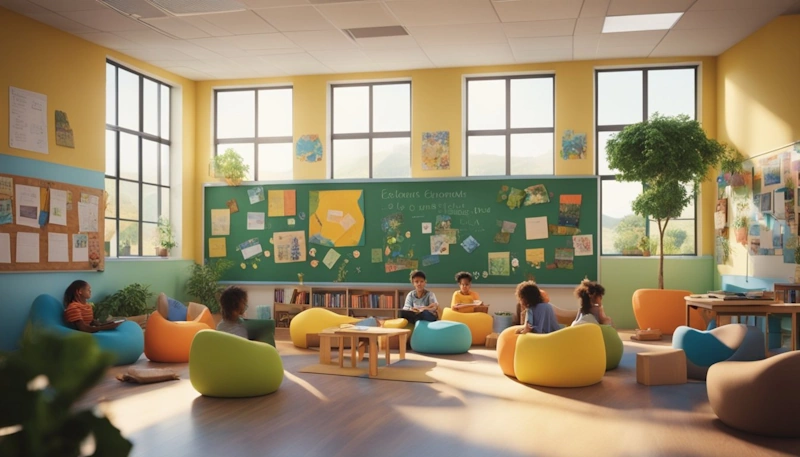
A positive classroom culture is key to student success. It helps kids feel safe, valued, and eager to learn. Undoubtably, when students enjoy coming to class, they’re more likely to do well in their studies.
First and foremost, creating a positive classroom culture starts with setting clear rules and expectations. You can involve your students in this process. Ask them what they think makes a good classroom environment. This helps them to feel ownership and responsibility for following the rules.
Furthermore, building strong relationships with your students is another important step. Get to know each child as an individual. Show interest in their lives outside of school. When students feel connected to their teacher, they’re more motivated to participate and learn. You can also use surveys to better understand your students’ likes and dislikes. Without a doubt, this information can help you tailor your teaching to their interests.
Establishing a Positive Classroom Culture
Creating a welcoming classroom starts with setting clear rules and using good management skills. You can build a classroom where students feel safe to learn and grow.
Setting Clear Expectations to Foster Affirmative Classroom Culture
You should start the year by setting clear classroom rules with your students. Get them involved in making these rules. This helps them feel like they have a say in how the class runs. Write down the rules and put them up where everyone can see them. Go over the rules often to remind students.
To add, make sure to explain why each rule matters. For example, “We raise our hands to speak so everyone gets a chance to be heard.” When students understand the reasons behind rules, they’re more likely to follow them.
In other words, praise students when they follow the rules. This encourages good behaviour and helps create a positive vibe in your classroom. Need 3 teaching tips? Then check out this post!
Positive Classroom Culture
A positive classroom culture helps your students feel safe and ready to learn. You can build this by showing you care about each student. Learn their names quickly and ask about their interests.
Likewise, create chances for students to work together and help each other. Group your students based on ability and/or interests can help with this. It is important to make sure everyone feels included and valued.
I believe that it is important to celebrate small wins and progress. This could be as simple as clapping when someone solves a hard problem. Moreover, when students feel good about their efforts, they’re more likely to keep trying.
To conclude, use kind words and a friendly tone. Your attitude sets the mood for the whole class.
Implementing Effective Classroom Management
Good classroom management keeps things running smoothly. Have a clear daily routine so your students know what to expect. This could be as simple as having an online document that the students can view each morning or a visual timetable that can be seen each day for younger students.
To add, use signals to get students’ attention, like a special clap or bell. Teach and practise these signals so everyone knows what they mean. This is very important at the beginning of each year. As they say, Term 1 is always the hardest.
Deal with problems quickly and quietly. Talk to your students one-on-one instead of calling them out in front of everyone. This helps keep their dignity intact.
Be fair and consistent with consequences. Make sure the punishment fits the action. For example, if someone makes a mess, they should clean it up.
In addition, move around the room as you teach. This helps you see what’s going on and stop problems before they start.
Enhancing Student Engagement and Relationships

Boosting student engagement and building strong relationships are key to a positive classroom culture. These strategies help create a supportive learning environment where students feel valued and motivated to participate.
Fostering Collaboration and Teamwork
Did you know, group work and activities are great ways to encourage teamwork. You can set up small groups for discussions or problem-solving tasks. This will help your students learn from each other and develop important social skills.
Try using think-pair-share activities. Students think about a question on their own, then pair up to discuss their ideas. Finally, they share with the whole class. This gets everyone involved and talking.
Likewise, you can also use jigsaw activities. Split the class into groups, with each group learning about a different topic. Then, mix the groups so students can teach each other what they’ve learned. This builds confidence and communication skills
Building Positive Relationships and a Sense of Belonging
Getting to know your students is crucial. Take time to chat with them about their interests and lives outside school. This shows you care and helps build trust.
Use icebreaker games at the start of the year to help students get to know each other. Simple activities like ‘two truths and a lie’ can be fun and break down barriers.
Furthermore, create a classroom contract together. Ask your students what they think makes a good learning environment. Write down their ideas and display them in the room. You can then use this as a lesson idea. You can go over which of the ideas is feasible and which ones are not. Finally, you can implement the doable ones in your classroom over time.
Promoting Social-Emotional Learning to Build Classroom Culture
Teaching social-emotional skills is just as important as academic subjects. These skills help students manage their emotions and get along with others.
You can use role-play activities to practise social skills. For example, your students could act out how to resolve conflicts or show empathy.
Mindfulness exercises can help students learn to focus and calm themselves. Try short breathing activities or guided visualisations at the start of lessons.
For instance, encourage students to set personal goals and reflect on their progress. This helps them develop self-awareness and motivation. You could use diaries or regular check-ins to support this process.
Strategies for Academic Empowerment

Creating a positive classroom culture involves empowering students academically. This helps build confidence, promotes learning, and fosters success
Encouraging a Growth Mindset
A growth mindset is key to academic success. Teach your students that their abilities can improve with effort. Praise hard work and progress, not just results. Use phrases like “You’re on the right track” or “Your practice is paying off.”
Apart from this, encourage your students to view mistakes as learning opportunities. When they face challenges, prompt them to think of new strategies. Create a classroom wall where students share their “lightbulb moments” or breakthroughs.
To sum up, set achievable goals with your students. Break big tasks into smaller steps. This helps students see their progress and builds confidence.
Utilising Positive Reinforcement When Building Classroom Culture
Positive reinforcement can boost academic performance. Use specific praise to highlight good work. For example, say “Your essay had strong arguments” instead of just “Good job.”
Create a reward system for academic effort. This could be stickers, certificates, or extra free time. Make sure to recognise improvement, not just top marks.
Use peer recognition too. Have students give each other “shout-outs” for helping or trying hard. This builds a supportive classroom culture.
Consider using a points system (like class Dojo) where your students earn rewards for academic achievements. This can make learning feel like a fun game.
Incorporating Inclusivity in Learning
An inclusive classroom helps all students succeed. Use different teaching methods to suit various learning styles. This might include visual aids, hands-on activities, and group discussions.
Provide options for assignments. Let your students choose how to show their learning. This could be through writing, art, or presentations.
Use diverse examples in your lessons. This will help all your students feel represented and engaged. Make sure your classroom library has books with diverse characters and authors.
To conclude, encourage group work to build social skills. Mix up the groups regularly so your students work with different classmates. Teach skills for good teamwork, like active listening and sharing ideas.
Conclusion
Ultimately, building strong relationships with your students is key to fostering a positive classroom culture. Getting to know each of your students as an individual is vitally important. One way to do this is to ask simple questions about what they did on the weekend and asking relevant questions. For example, I had a student in my class that was into camping and fishing. I would always ask about how many fish he caught and how big the fish he caught was. I got to know the type of fish that inhabited the lake he went to.
In conclusion, you goal should be to have your students feel a connection to you. This will in turn, encourage them to be more motivated to participate and learn in your classroom. A happy learner will be more willing to complete their work and cause less problems.
I am interested in your ideas and thoughts about how you get to know your students.
About The Author

Hi! My name is Mr Mac. I am a K – 6 teacher. I love to create resources for teachers to make their teaching lives easier.



